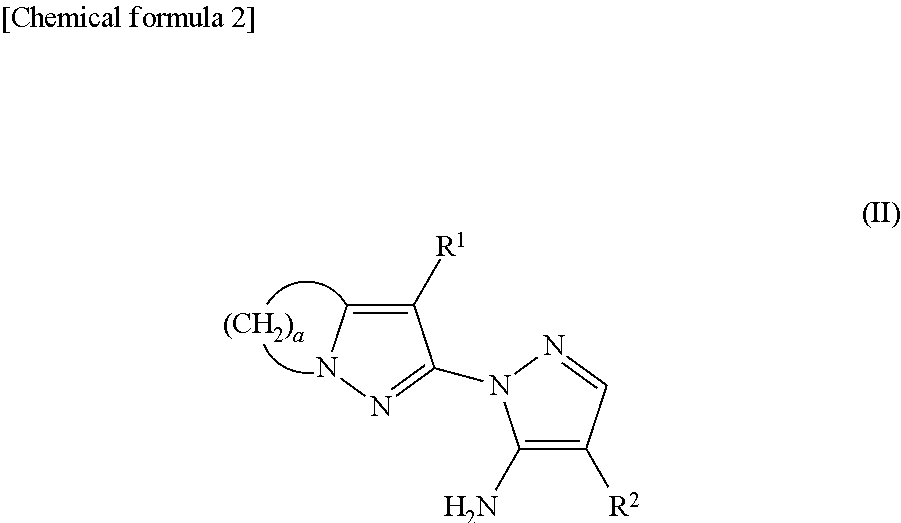Substituted pyrazolylpyrazole derivative and use of same as herbicide
a technology of pyrazolylpyrazole and substituted pyrazolylpyrazole, which is applied in the field of substituted pyrazolylpyrazole derivatives, can solve the problems of difficult to control all weeds with a single spray of herbicide, and extend the growth of perennial weeds, and achieves the effect of wide herbicidal spectrum
- Summary
- Abstract
- Description
- Claims
- Application Information
AI Technical Summary
Benefits of technology
Problems solved by technology
Method used
Image
Examples
example 1
Method for the Synthesis of 1-(3-chloro-4,5,6,7-tetrahydropyrazolo[1,5-a]pyridin-2-yl)-5-(2-methylprop-2-enylamino)pyrazole-4-carbonitrile (Compound 1)
[0069]Acetonitrile (75 ml) was added to 5-amino-1-(3-chloro-4,5,6,7-tetrahydropyrazolo[1,5-a]pyridin-2-yl)pyrazole-4-carbonitrile (19.7 g) followed by slowly dropping acetyl chloride (5.8 g) therein and refluxing for 5 hours. Following completion of the reaction, water was added to the reaction mixture and the precipitated solid was washed with ethyl acetate to obtain N-(1-(3-chloro-4,5,6,7-tetrahydropyrazolo[1,5-a]pyridin-2-yl)-4-cyanopyrazol-5-yl)acetamide (12 g).
[0070]N-(1-(3-chloro-4,5,6,7-tetrahydropyrazolo[1,5-a]pyridin-2-yl)-4-cyanopyrazol-5-yl)acetamide (2.5 g) was dissolved in acetonitrile (8 ml) followed by the addition of potassium carbonate (1.3 g) and stirring. 3-chloro-2-methyl-1-propene (0.8 g) was then added thereto followed by refluxing for 8 hours. Following completion of the reaction, water was added to the reaction...
example 2
Method for the Synthesis of 1-(3-chloro-4,5,6,7-tetrahydropyrazolo[1,5-a]pyridin-2-yl)-5-(2-chloroprop-2-enylamino)pyrazole-4-carbonitrile (Compound 2)
[0071]Formic acid (18.4 g) was slowly dropped into acetic anhydride (33.7 g) cooled to 5° C. followed by stirring for 2 hours at 60° C. (Reaction Mixture A). Separate from the above, 5-amino-1-(3-chloro-4,5,6,7-tetrahydropyrazolo[1,5-a]pyridin-2-yl)pyrazole-4-carbonitrile (26.3 g) was dissolved in acetonitrile (200 ml) and stirred. The previously prepared Reaction Mixture A was slowly dropped therein and reacted for 1 day at room temperature and then for 4 hours at 60° C. Subsequently, the solvent was concentrated under reduced pressure followed by neutralizing using aqueous potassium carbonate solution, washing the precipitated solid with water and drying to obtain N-(1-(3-chloro-4,5,6,7-tetrahydropyrazolo[1,5-a]pyridin-2-yl)-4-cyanopyrazol-5-yl)formamide (28 g).
[0072]N-(1-(3-chloro-4,5,6,7-tetrahydropyrazolo[1,5-a]pyridin-2-yl)-4-cy...
example 3
Method for the Synthesis of (N-1-(3-chloro-4,5,6,7-tetrahydropyrazolo[1,5-a]pyridin-2-yl)-4-cyanopyrazol-5-yl)-N-(2-chloroprop-2-enyl)-2,2,2-trifluoroacetamide (Compound 3)
[0074]1-(3-chloro-4,5,6,7-tetrahydropyrazolo[1,5-a]pyridin-2-yl)-5-(2-chloroprop-2-enyl)pyrazole-4-carbonitrile (0.7 g) was dissolved in acetonitrile (5 ml) followed by slowly dropping in trifluoroacetic anhydride (1.3 g). After stirring for 7 days at 40° C., saturated aqueous sodium hydrogen carbonate solution was added to the reaction liquid followed by extracting with ethyl acetate. After drying with sodium sulfate, the solvent was distilled off under reduced pressure and the resulting crude product was purified by silica gel column chromatography (hexane / ethyl acetate=4:1) to obtain the desired compound (0.4 g).
[0075]The starting material in the form of the compound of formula (II) was synthesized in accordance with WO 93 / 10100 and WO 94 / 08999.
[0076]The examples listed in the following tables can be synthesize...
PUM
| Property | Measurement | Unit |
|---|---|---|
| temperature | aaaaa | aaaaa |
| depth | aaaaa | aaaaa |
| temperature | aaaaa | aaaaa |
Abstract
Description
Claims
Application Information
 Login to View More
Login to View More - R&D
- Intellectual Property
- Life Sciences
- Materials
- Tech Scout
- Unparalleled Data Quality
- Higher Quality Content
- 60% Fewer Hallucinations
Browse by: Latest US Patents, China's latest patents, Technical Efficacy Thesaurus, Application Domain, Technology Topic, Popular Technical Reports.
© 2025 PatSnap. All rights reserved.Legal|Privacy policy|Modern Slavery Act Transparency Statement|Sitemap|About US| Contact US: help@patsnap.com



